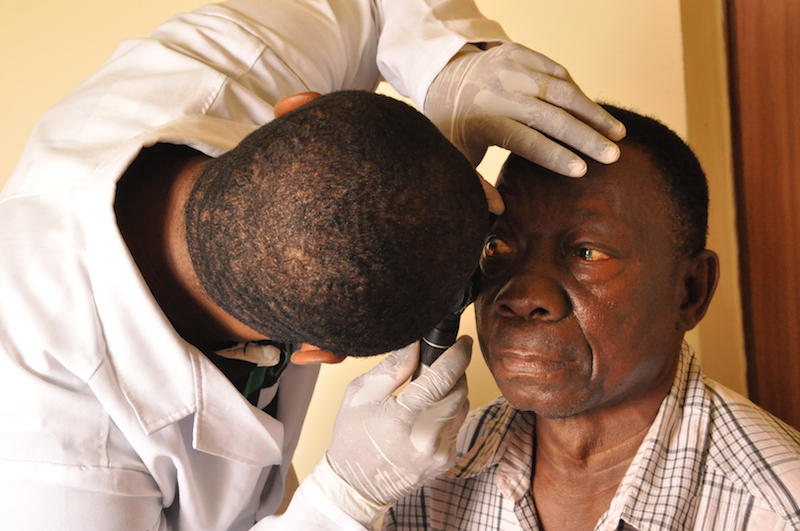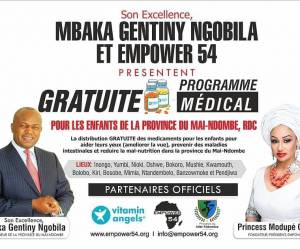2014-11-23
November 23rd and November 29th 2014 Empower 54 conducted a free medical mission and food donation programs that included distribution of medical glasses and medication, in the dangerous creeks of Bayelsa State. The humanitarian program had two teams- the medical team, which performed eye examinations, gave out medication and glasses to the underprivileged, and the food drive team went to both inland and riverine communities in the dangerous creeks distributing bags of rice to the poor. The eye care community outreach program is a unique program created by Empower 54 to address the growing need for vision health care services for medically underserved individuals especially with the high rate of river blindness in these riverine and fishing communities in the Niger Delta region of Nigeria. Ophthalmology Team Case Report The week long mission trip was composed by six eye doctors. The teem travelled to 5 different villages in Bayelsa namely; (i) Otuoke (ii) Otuaba (iii) Anyama (iv) Opume, and (v) Otuogere. It is an organization aimed at helping people who do not have access to eye care. 1700 patients were examined under 5 days. 15% were found to need distance correction, 50% near correction, 30% had moderate visual impairment, pathological cases and blindness. 5% of patients were referred for further ophthalmological investigation. 550 pairs of spectacles were dispensed and drugs were given out. OTUOKE: villagers examined in this area were found to have more reading problems due to age and pathological cases, such as Glaucoma, senile and traumatic cataract, floaters, few conjunctivitis, keratoconjunctivitis sicca and cornea ulcer, etc. Collected data was 450. 300 women, 130 men and 20 children were examined with the percentage of 65%, 30% and 5%. Glaucoma which is a leading cause of blind and it can be say to be increase in intra-ocular pressure was seen in elderly and few young children. Traumatic cataract can be defined as an opacification of the lens was seen in young adults and the result of this case is due to trauma either as a result of fight or accident etc. Drugs given to the patients were anti-infective, anti-glaucoma, Anti-inflammatory, Anti-Allergy, Artificial tears, Anti-histamine, vitrolent, anti-biotics, eye- ointment, vitamins (A, B, &C), yeast, and paracetamol, etc. and also counseling. OTUABA: people examined in this area have more similar cases with those in Otuoke. The number of the population seen in this area was 200 villagers. 100 women, 85 men and 15 children. ANYAMA: the population that was examined in this area has more pathological example onchocerciasis was blindness, cataract, glaucoma than refractive errors. Their occupations were mainly farming, fishing and while others unemployed The environment in Anyama is very unhealthy. It was filled with highly polluted waters. No good hospitals and medical personnel to take care of the people there. Collected data in this area was 300. 205 women, 70 men and 25 children. Their children suffer allergic conjunctivitis, congenital glaucoma and onchocerciasis while their elderly once suffer blindness, cataract, glaucoma, pterygium, floaters, allergic conjunctivitis etc. Some cases were due to ignorance and lack of awareness of the women. The breast feeding mothers poured breast milk into the eyes of their children, using urine and some traditional herbs to help prevent river blindness. Drugs were prescribed, reading glasses were dispensed and we counseled them on personal hygiene and the importance of good sight. OPUME: Opume town have good environment, good school, equipped hospital. But, the only problem in the village is the small dirty river that runs across the community. Examined people were 350. Their men were 50 in number, 200 women and 100 children. The most incident cases were refractive errors, pathological cases and presbyopic problems. Due to the dirty river, some cases of onchocerciasis (river blindness) were seen in the area and other pathological cases such as allergic conjunctivitis glaucoma, cornea ulcer, cataract, bacterial – conjunctivitis , kerato conjunctivitis sicca were also present in the place. Reading glasses and drugs were dispensed, and the villagers were counseled. OTUOGERE: the population examined in the area was done under the rain. Seen villagers was 100 in number. Drugs and reading glasses were given out under that condition. We counseled them and collected all the data needed. SUMMARY The key challenges for rural and remote population in a number of areas in Bayelsa are such as demography (age, race, and gender), health status and work force. We found out that Bayelsans living in rural areas rate more poorly than Bayelsans living in major cities. Across a range of health status measures, these include: life expectancy, self-reported health status and chronic disease prevalence. Another challenge is the inability of the people to see good specialist and optometrists to practice in the region, which affect many of them developing, allergic conjunctivitis, Glaucoma, cornea ulcer, floaters, kerato conjunctivitis sicca, onchocerciasis which can lead to blindness. For the elderly ones more reading glasses are needed since many of them complained of not being able to put tread in the needle. CASES SEEN: Allergic Conjunctivitis Kerato- Conjunctivitis (dry eye) Glaucoma (raised intraocular pressure) Cataract Cornea Ulcer, Floaters Onchocerciasis Bacteria Conjunctivitis Pterygium Refractive Errors Presbyopia Pinguecula Sub-conjunctival Haemorrhage Blepheritis. RECOMMENDATION AND CONCLUSION Establishing more community outreach programs in the region is critical as it will prevent a lot of people from losing their sight. Total population of people examined by the Empower 54 ophthalmology team in Bayelsa were 1700. 900 women, 700 men and 100 children. Counseling, drugs and spectacles were given to them especially the elderly ones that have presbyopia on how to use their reading glasses and eye drops.
2340
Communities Reached
700
Executed Projects
663509
Global Outreach



